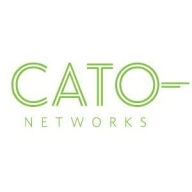


Check Point CloudGuard Network Security and Cato SASE Cloud Platform compete in the network security space. Cato SASE Cloud Platform appears to have the upper hand due to higher user satisfaction with its features.
Features: Check Point CloudGuard Network Security offers robust threat prevention, detailed security policies, and comprehensive network protection. Cato SASE Cloud Platform combines security with wide-area networking, providing an all-in-one solution, integrated security, and networking services seamlessly. Users find Cato's integrated approach and superior features more holistic.
Room for Improvement: Check Point CloudGuard Network Security needs better integration with third-party tools, simpler management options, and enhancements in user interface intuitiveness. Cato SASE Cloud Platform could improve its analytics, reporting features, and scalability. Users find Cato's straightforward management preferable.
Ease of Deployment and Customer Service: Check Point CloudGuard Network Security deployment is complex, requiring detailed setup and configuration. Customer service is effective but can be slow. Cato SASE Cloud Platform has a straightforward deployment process and responsive customer service. Users report Cato is easier to deploy and better supported.
Pricing and ROI: Check Point CloudGuard Network Security has a competitive initial setup cost but mixed ROI due to high ongoing expenses. Cato SASE Cloud Platform, while more expensive initially, offers better ROI due to its wide-ranging feature set and ease of use. Users are willing to invest more in Cato due to these factors.
Clients are now comfortable and not wasting productive hours on IT support.
The automation part is giving us a cost benefit and speed; we can react faster.
It's a very useful tool to mitigate and protect your enterprise.
The value lies in maintaining operational integrity with zero downtime or incidents, facilitating secure, ongoing business operations.
Implementing CloudGuard has resulted in an excellent return on investment over one hundred percent ROI.
The unified policy is comprehensive and helps me to create firewall policies that are shared across all our facilities and plants.
They offer very accurate solutions.
The quick resolution of issues with Fortinet FortiGate is due to the support of the company and the fact that the equipment is easy to work with.
I would rate the technical support for Fortinet FortiGate a ten out of ten.
Their knowledge portal and Cato Academy portal are excellent resources.
Our customer service experience is excellent
They provide very good technical support.
They usually respond quite fast, and they are very knowledgeable about what they do.
We had an endless loop of emails trying to fix this, and the suggestion was to reinstall the gateway and do it from scratch, which was not an option at that point because it would leave that specific location without access.
Available twenty-four by seven.
They scale up really well from smaller models like the FortiGate 40 and 50 to bigger sites with the FortiGate 100 for more throughput - up to enterprise datacenters.
The variation comes in terms of the interfaces and throughputs, but from a security perspective, you get the same benefit, irrespective of whether you have an entry-level unit or an enterprise.
We determine sizing based on multiple factors: number of users, available links, traffic types, server count, services in use, and whether services will be published.
As an MSSP, we find it scalable for end users across EPP platforms, network, and cloud sides.
I can deploy it everywhere I need it.
We have transitioned from 1,000 to 500 users without any issue.
We perform minor and major upgrades, and it works seamlessly.
We're experiencing 99.999% availability consistently.
I would rate the stability of Fortinet FortiGate a ten out of ten.
Currently, we are experiencing a general outage of one of the main internet service providers of the Dominican Republic, and we have not been impacted in our operations because with SD-WAN, we have another internet service provider and we are working with the second WAN connection without any disruption.
I would rate the stability of the solution as ten on a scale of one to ten.
We have not seen many issues with Cato SASE Cloud Platform recently.
I have not observed any downtime.
For instance, when we are working on a release and do an upgrade, we start experiencing unexpected issues.
The solution is stable.
Investing in a solution that can accommodate such growth would be more cost-effective than repeatedly purchasing new hardware.
While Fortinet claims to offer a comprehensive network solution, it falls short in addressing computer application issues, particularly server security.
When considering Sophos XG, which we also use, the logging and reporting functionality is notably more efficient.
The platform lacks strong security features on the edge.
The kind of integrations they offer today, in the future, I would think they would add more and more feature sets, especially around where they remove the dependency of having specialist solutions on a typical monitoring side.
Scalability could be improved as well; needing to purchase a new license each time I want to add a new interface is not ideal.
Better documentation would be welcome.
The user interface could be more intuitive, and the initial setup and configuration can be complex, requiring a technical team.
Last year, I renewed the support for three years, which can sometimes be expensive but depends on the security benefits and how it helps us.
It offers cost savings as it is generally cheaper than the competition.
It is about 20% cheaper.
The features are available for much less than Palo Alto.
The pricing is flexible due to our special partnership with Cato Networks.
The pricing and licensing are expensive, costing between seven thousand to eight thousand dollars.
Check Point is expensive, however, with the features and capabilities, I can justify the cost.
It is the highest in the market.
In terms of security, we have not experienced any security flaws or loopholes, and it has proven to be quite stable.
FortiGate has helped reduce the risk of cyberattacks that might disrupt our client's production.
These features help reduce our downtime, manage the ISPs, and deploy SLAs for all the website traffic.
It is scalable for end users across network and cloud sides and saves operational costs.
They offer a very lightweight and powerful console where it has everything needed to manage as a service.
One of the most valuable features is the automated threat prevention, which helps us detect and block potential cyberattacks in real-time, minimizing data breaches.
Centralized management is the feature I like best, resulting in reduced workload and more continuous policy.
Network Security provides us with unified security management across hybrid and cloud as well as on-prem.
| Product | Market Share (%) |
|---|---|
| Fortinet FortiGate | 18.3% |
| Check Point CloudGuard Network Security | 1.7% |
| Cato SASE Cloud Platform | 7.8% |
| Other | 72.2% |



| Company Size | Count |
|---|---|
| Small Business | 350 |
| Midsize Enterprise | 130 |
| Large Enterprise | 187 |
| Company Size | Count |
|---|---|
| Small Business | 14 |
| Midsize Enterprise | 7 |
| Large Enterprise | 10 |
| Company Size | Count |
|---|---|
| Small Business | 59 |
| Midsize Enterprise | 38 |
| Large Enterprise | 75 |
Fortinet FortiGate excels in providing integrated VPN, firewalling, and Unified Threat Management (UTM) with centralized management and high availability. It supports remote access and comprehensive threat protection, making it a preferred choice for securing networks.
Fortinet FortiGate offers a robust security platform with features such as strong intrusion prevention, application control, and web filtering. Its integration with Active Directory and SD-WAN functionality provides scalable solutions for large networks. Users appreciate its ease of use through centralized management interfaces, ensuring robust security with flexible configurations. However, FortiGate could enhance its graphical interface and technical support responsiveness, address firmware bugs and costly licensing, improve logging, integrate better with third-party tools, and strengthen scalability and memory for log storage. Complexity in configuration and the need for intuitive features are noted challenges, and there's a demand for advanced security, zero-trust capabilities, and AI integration.
What are the key features of Fortinet FortiGate?Fortinet FortiGate is widely implemented across industries like education, finance, and government. Companies use it for firewall protection, VPN, and SD-WAN capabilities, ensuring secure perimeter and data center security. It facilitates remote access management and traffic routing optimization, offering reliable security and connectivity solutions.
Cato Networks is a leading SASE (Secure Access Service Edge) platform, combining SD-WAN and network security to obtain a cloud-native service. Cato Networks optimizes and secures application access for users and identities. The platform delivers a next-generation secure networking architecture that minimizes legacy IT infrastructures’ complexity, costs, and risks. The goal of Cato Suite is to connect any user to any application securely and optimally.
Cato Suite runs on a private global network of more than 65 PoPs (points of presence) connected via SLA-backed network providers. The service can connect branches, data centers, users, and clouds. Cato can be deployed in stages to augment legacy network services.
Cato Suite delivers end-to-end route optimization for WAN and cloud traffic. The architecture is self-healing, enabling a high service uptime.
Cato Features
Cato Cloud has a global backbone to deliver a reliable, global network. Here are some key SD-WAN features of Cato Cloud.
What challenges does Cato Network solve?
MPLS (multi-protocol label switching) networks are usually expensive and limited in their capacity. Cato simplifies migrating to a faster, higher-capacity internet and SASE cloud. Cato SD-WAN appliances enable customers to improve usable capacity and resiliency.
Customers who suffer from the challenge of high latency and network inconsistency can use Cato to deliver a consistent connection and user experience to access on-premises and cloud applications.
Cato’s complete network security stack connects all branch locations to the Cato cloud, therefore protecting all traffic, both internet-bound and WAN, with enterprise-grade, cloud-based security services. This capability avoids having to backhaul internet traffic to a data center or hub or having to implement stand-alone cloud security solutions.
Organizations using Cato notice an acceleration of cloud traffic. Cato achieves this by routing all traffic from the edges to the PoP closest to the data center. Because of the close distance between the two, the latency is near zero.
Reviews from Real Users
An IT manager/project coordinator at a healthcare company says that “[Cato is] a cloud-based solution that integrates well with everything. They are the classic SaaS solution.”
Yeong-Gi L., a network engineer at Snetsystems, notes that “The solution is very stable. The scalability is quite good. Technical support was always helpful and responsive. The integration capabilities are not a problem at all.”
"The most valuable feature is that it also works as a next-gen firewall because it has security features," says Lorenzo S., senior solutions consultant Lead at MDI.
Check Point CloudGuard Network Security offers centralized management, robust threat prevention, and seamless integration with major public clouds, ensuring consistent security for cloud and on-premises environments. It combines ease of use with flexibility across diverse IT infrastructure.
Check Point CloudGuard Network Security provides comprehensive protection for IT infrastructures in AWS, Azure, and hybrid environments. It ensures firewall security, managing traffic and securing cloud infrastructures while maintaining network protection and compliance enforcement. Organizations benefit from its centralized security governance, enhanced visibility, and threat prevention for both perimeter and internal security. It offers seamless integration with leading cloud platforms, allowing for efficient deployment and scalability, aligning with modern cloud requirements.
What are the key features of Check Point CloudGuard Network Security?In industries such as finance, healthcare, and tech, Check Point CloudGuard Network Security is vital for protecting sensitive data, managing compliance, and safeguarding daily operations. Its robust integration capabilities support diverse infrastructure setups, assisting companies in maintaining high-security standards efficiently.
We monitor all Software Defined WAN (SD-WAN) Solutions reviews to prevent fraudulent reviews and keep review quality high. We do not post reviews by company employees or direct competitors. We validate each review for authenticity via cross-reference with LinkedIn, and personal follow-up with the reviewer when necessary.